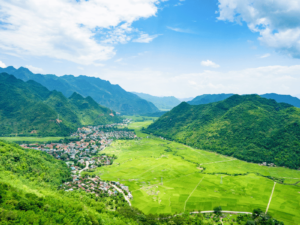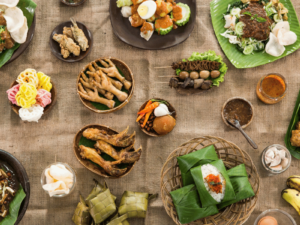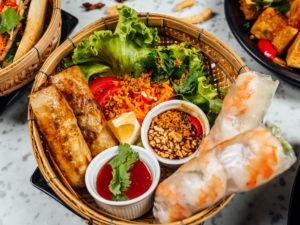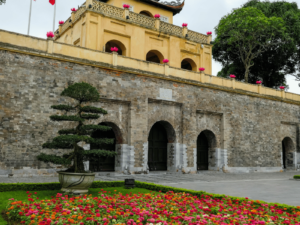✨ Street Food Tours – Dive into Vietnam’s Soul
If you want to feel the true heartbeat of Vietnam, you’ll find it sizzling on the sidewalks and hidden down narrow alleyways. Street food is not just an essential part of Vietnamese life — it’s a living, breathing celebration of flavor, community, and history.
On a Vietnamese street food tour, you’ll stroll through lively markets and vibrant neighborhoods, following the smoky scent of grilled meats, the comforting aroma of noodle broths, and the rhythmic clatter of woks dancing over open flames.
Some unmissable highlights include:
- Pho in Hanoi: Wake up early to slurp a steaming bowl of pho at a bustling morning market, where the broth simmers for hours and the noodles are made fresh daily.
- Banh Mi in Hoi An: Bite into the perfect combination of crisp baguette, rich pâté, savory pork, and pickled vegetables — a beautiful blend of Vietnamese and French influences.
- Seafood Barbecue in Saigon: As night falls, join locals at sidewalk grills, picking fresh clams, prawns, and fish cooked right before your eyes and seasoned with nothing but salt, chili, and lime.
Beyond the dishes themselves, street food tours offer something deeper: a chance to sit shoulder-to-shoulder with locals, to hear stories behind the recipes, and to feel the lively pulse of everyday Vietnamese life. You won’t find this experience in any five-star restaurant — it’s raw, it’s real, and it’s unforgettable.
Insider Tip: Don’t worry about the plastic stools or the open-air settings — some of Vietnam’s most unforgettable meals are found on the humblest of street corners.
📚
“Vietnam was named one of the top 5 street food destinations globally by CNN Travel, thanks to its variety, affordability, and authenticity.”
(Source: CNN Travel, 2023)
✨ Market-to-Table Tours – Where Freshness Begins
To truly understand Vietnamese cuisine, you must start at its heart: the bustling, colorful local markets where life hums with energy and every corner bursts with the scent of fresh herbs, tropical fruits, and sizzling street snacks.
A Market-to-Table Tour in Vietnam isn’t just a food tasting — it’s a deep dive into the daily rhythm of local life.
You’ll wander through narrow aisles piled high with vibrant produce, bargain with cheerful vendors over bundles of fragrant mint and coriander, and learn how essential ingredients like fish sauce, rice noodles, and spices shape the nation’s beloved dishes.
Some market experiences not to miss:
- Ben Thanh Market (Ho Chi Minh City): This iconic market offers a whirlwind of flavors, from piping hot bowls of bun thit nuong (grilled pork with vermicelli) to sweet che desserts layered with coconut milk and mung beans.
- Dong Xuan Market (Hanoi): Step into a lively maze of food stalls serving northern Vietnamese specialties like bun rieu (crab noodle soup) and nem cua be (crab spring rolls).
- Hoi An Central Market: Here, you can pick fresh ingredients for a hands-on cooking experience, learning to make classic dishes like cao lau or banh xeo from scratch.
What makes Market-to-Table Tours special is the intimate connection between place, people, and plate. It’s one thing to taste a bowl of noodles; it’s another to see the smiling woman who made them, to smell the herbs she picked that morning, and to hear her story.
Insider Tip: Go early in the morning! Vietnamese markets are liveliest before noon, and you’ll catch the freshest produce — plus the most authentic interactions.
📚
“Local markets are the soul of Vietnamese culinary culture, providing 80% of daily food supplies nationwide.”
(Source: Vietnam Tourism Authority, 2023)
✨ Hidden Gems Food Tours – Secrets Only Locals Know
While street food markets and famous eateries often make the headlines, Vietnam’s true culinary treasures are hidden away — down side alleys, behind old doorways, and tucked inside family homes passed down through generations.
Hidden Gems Food Tours are designed for curious travelers eager to go beyond the obvious. These tours reveal places not featured in guidebooks — the tiny stalls and family-run kitchens that locals swear by.
Some must-try hidden experiences include:
- Late-Night Pho Stalls in Hanoi: Skip the touristy pho shops and pull up a plastic stool at a backstreet pho gánh, where bubbling broth is served straight from a pot balanced on a street vendor’s shoulder.
- Com Tam Alleyways in Saigon: Wander into narrow lanes in District 1 and find smoky little joints serving Com Tam (broken rice) with grilled pork chops, a dish as beloved to locals as burgers are to Americans.
- Banh Can Stands in Da Lat: Search for wood-fired griddles tucked away on Da Lat’s chilly backstreets, where Banh Can (mini savory pancakes) are cooked to perfection and paired with fragrant fish sauce.
The beauty of a Hidden Gems Food Tour lies not only in the food — though that’s unforgettable — but in the stories you’ll collect: the grandmother who has been making the same sticky rice for 50 years, the vendor who remembers feeding three generations of neighborhood kids.
Insider Tip: Bring an adventurous spirit and an open mind. Some of the best bites come from the most unassuming spots!
📚
“The most memorable meals often come from places you’d walk past without noticing.”
(Source: Lonely Planet, Vietnam Food Guide, 2023)
✨ Heritage Food Tours – Taste History and Culture
In Vietnam, food is much more than sustenance — it is a vessel for storytelling, a living testament to centuries of cultural evolution. On a Heritage Food Tour, you’ll not only eat unforgettable dishes but also journey through time, learning how wars, migrations, and royal dynasties have shaped what’s on your plate today.
Every region, every city has its own culinary legacy. Some essential heritage experiences include:
- Banh Chung and Banh Tet during Tet (Lunar New Year): These sticky rice cakes, wrapped carefully in banana leaves, symbolize gratitude, family, and prosperity. Making them is a labor of love that families pass down through generations.
- Cao Lau in Hoi An: Unique to this UNESCO heritage town, Cao Lau noodles are hand-made using water drawn from ancient Cham wells. It’s a dish you can’t find anywhere else in Vietnam — or the world.
- Bun Bo Hue in Central Vietnam: This spicy, aromatic beef noodle soup originated in the imperial kitchens of Hue, offering a richer, bolder flavor compared to the delicate broth of northern pho.
What sets Heritage Food Tours apart is the deeper connection they offer: the understanding that every bite you take is woven into Vietnam’s rich historical tapestry. You’re not just savoring flavors — you’re savoring centuries of resilience, tradition, and innovation.
Insider Tip: Take your time. Ask your guide for the backstory behind each dish — the legends, the rituals, and the subtle regional variations. It will change the way you taste everything.
📚
“Vietnamese cuisine is a reflection of the country’s layered history — each dish tells a story of culture, conflict, and community.”
(Source: Condé Nast Traveler, 2023)
✨ Farm-to-Table Experiences – Fresh, Local, Sustainable
As global travelers grow more conscious about where their food comes from, Farm-to-Table Experiences in Vietnam offer a refreshing, hands-on way to connect with the land, the farmers, and the fresh ingredients that define Vietnamese cuisine.
Unlike bustling street corners or lively markets, farm tours immerse you in the quiet rhythms of rural life. You’ll swap city noise for the soft sounds of rustling vegetable leaves and the aroma of rich, earthy soil after rain.
Unmissable farm-to-table experiences include:
- Organic Farms in Da Lat: Nestled in the cool Central Highlands, Da Lat’s lush farms grow everything from strawberries to crisp lettuces. Spend a morning harvesting your own vegetables, then learn to cook simple, farm-fresh dishes bursting with flavor.
- Tra Que Vegetable Village in Hoi An: Just a short bicycle ride from Hoi An’s ancient town, this tranquil village has been supplying herbs and vegetables to local markets for centuries. Join farmers in tilling the soil, picking fragrant basil and coriander, and savoring a rustic lunch prepared straight from the garden.
Farm-to-table tours are not just about eating well — they are about understanding the deep respect for nature embedded in Vietnamese food culture. Every sprig of mint, every crisp bean sprout, carries with it the hard work and traditions of local communities.
Insider Tip: Don’t hesitate to get your hands dirty! Participating in planting or harvesting makes your farm-fresh meal taste even better — and gives you a story worth telling.
📚
“Farm-to-table experiences are redefining culinary tourism, offering travelers authentic, sustainable connections to the places they visit.”
(Source: World Food Travel Association, 2023)
✨ Why Choose Food Type Tours Over Cooking Classes?
Cooking classes have their charm — rolling fresh spring rolls or stirring fragrant curries in a cozy kitchen is certainly a delightful experience.
But if you’re craving a deeper, more vibrant connection to Vietnam, Food Type Tours offer something even richer.
Here’s why:
Authenticity at Every Turn
When you join a street food tour or explore a bustling market, you experience Vietnam’s daily life in real time.
You don’t just learn a recipe — you witness where locals eat, shop, and celebrate. It’s a raw, unscripted slice of life that no cooking class can fully replicate.
More Flavors, More Stories
Food Type Tours expose you to a broader spectrum of tastes: the tang of street-side pickles, the smoky richness of roadside grills, the sweetness of fresh dragon fruit straight from a market stall.
Each bite tells a different story — about geography, history, migration, and community.
Greater Flexibility and Adventure
Unlike structured classes, food tours are dynamic and spontaneous.
Feel like stopping for an extra snack? Curious about an unfamiliar smell wafting from a nearby cart? With Food Tours, you have the freedom to wander, explore, and embrace the unexpected.
Local Connection Beyond the Kitchen
It’s not just about food — it’s about people.
You’ll meet farmers tending their fields, vendors proudly showcasing their specialties, and locals eager to share a smile or a story — even across language barriers.
In short, if you’re seeking not just to cook Vietnamese food, but to live Vietnamese food, then Food Type Tours are your gateway.
Because in Vietnam, food isn’t just something you make — it’s something you experience, breathe, and remember.
📚
“Travelers increasingly seek authentic, immersive food experiences that connect them with local culture and communities.”
(Source: We Are Social & Hootsuite, Global Digital Report 2024)
✨ Bonus Section: Important Tips When Choosing a Food Tour in Vietnam
Choosing the right food tour can make the difference between an average experience and an unforgettable journey into Vietnam’s culinary soul. Here are a few important tips to keep in mind:
Check for Local Expertise
Look for tours led by locals or long-time residents. They know the hidden gems, the backstories, and the subtle regional differences you won’t find in guidebooks.
✅ Tip: Choose small-group or private tours for a more personalized, authentic experience.
Prioritize Authenticity Over Popularity
The best food is often found off the beaten path.
Be cautious of tours that only take you to well-known touristy spots — you want real local flavors, not mass-produced versions.
✅ Tip: Read recent reviews carefully. Look for words like “authentic,” “hidden,” and “local favorite.”
Understand the Focus of the Tour
Some tours focus on eating, others include cooking classes, market visits, or even farming activities.
Make sure you pick one that aligns with your travel style — whether you want to taste a variety or deep-dive into one particular aspect.
✅ Tip: If you love spontaneity, choose flexible tours where you can explore at your own pace.
Be Open to New Flavors and Settings
Vietnamese food can be adventurous — think snail dishes, fermented shrimp paste, or durian desserts.
Keeping an open mind (and an open palate) will reward you with the richest experiences.
✅ Tip: Ask your guide for “must-try but lesser-known” dishes for true bragging rights.
Mind Food Safety and Comfort
While street food is generally safe in Vietnam, it’s smart to join reputable tours that prioritize hygiene.
Bring a small hand sanitizer, stay hydrated, and pace yourself — there’s always another delicious bite waiting around the corner!
✅ Tip: Let the guide know in advance if you have any dietary restrictions or allergies.
✨ Frequently Asked Questions (FAQ)
Is Vietnamese street food safe for foreigners?
Yes, in general, Vietnamese street food is safe — and absolutely worth trying!
To minimize any risks, stick with reputable food tours that know the cleanest, most reliable vendors, and always follow your guide’s recommendations.
What should I wear during a food tour in Vietnam?
Dress comfortably and casually.
Light, breathable clothes are ideal, especially for walking tours. Comfortable shoes are a must, and it’s smart to bring a hat or umbrella for sun or sudden rain.
Can vegetarians enjoy food tours in Vietnam?
Absolutely!
While Vietnam is famous for dishes like pho bo (beef noodle soup), it also offers fantastic vegetarian options like pho chay, banh xeo with vegetables, and fresh tofu-based meals.
Just let your tour guide know in advance so they can tailor stops accordingly.
How much should I tip my food tour guide?
Tipping is appreciated but not mandatory.
A typical tip ranges from 5–10% of the tour price, depending on the quality of the experience. Cash in Vietnamese dong (VND) is preferred.
Are food tours suitable for children or older travelers?
Yes!
Most food tours can be adapted to suit families with kids or elderly travelers.
Private or small-group tours are a great choice if you need a slower pace or more flexibility with food options.
Do I need to book food tours in advance?
It’s highly recommended.
Especially during high travel seasons (like December to March or summer holidays), popular food tours in cities like Hanoi, Hoi An, and Ho Chi Minh City can sell out quickly. Booking early ensures you get the time slot and tour you prefer.
Will language barriers be a problem during local food tours?
Not at all.
Most reputable tours provide English-speaking guides who bridge any language gaps.
In fact, part of the fun is interacting with locals through smiles, gestures, and the universal language of good food!
Conclusion
In Vietnam, food is never just food.
It’s a living tradition, a gathering of communities, a celebration of identity — and an invitation to connect.
By choosing a Food Type Tour, you’re not simply tasting dishes. You’re stepping into family kitchens, sharing laughs over tiny street-side stools, bargaining for herbs in ancient markets, and honoring centuries of culinary artistry passed down through generations.
Every flavor you savor, every story you hear, will deepen your understanding of Vietnam far beyond what any guidebook can offer.
Ready to Taste the Real Vietnam?
Let your journey begin with a bite.
Join us on a local food adventure — and discover a side of Vietnam that’s unforgettable, unfiltered, and absolutely delicious.












